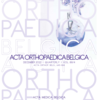Evaluation of the effect of intra-articular platelet-rich plasma and hyaluronic acid injections on femoral cartilage thickness in chronic knee osteoarthritis
Knee; osteoarthritis; platelet rich plasma; hyaluronic acid; cartilage thickness
Published online: Feb 17 2023
Abstract
Femoral cartilage thickness may be an important objective parameter in detecting the progression of knee osteoarthritis(KOA). In this study, we aimed to examine the possible effects of intra-articular Hyaluronic Acid(HA) and platelet-rich plasma(PRP) injections on femoral cartilage thickness and to investigate their possible superiority over each other in KOA. A total of 40 KOA patients were included in the study and randomized to the HA and PRP groups. Pain complaints, stiffness, and functional status were evaluated with the Visual Analog Scale(VAS) and Western Ontario and Mc Master Universities Osteoarthritis(WOMAC) indices. Ultrasonography was used for measuring the femoral cartilage thickness. At the 6th month measurements, significant improvements were observed in VAS-rest, VAS-movement, and WOMAC scores in both HA and PRP groups compared to the measurements performed before the treatment. No significant difference was observed between the effects of the two treatment methods. There were significant changes in the medial, lateral and mean cartilage thicknesses on the symptomatic knee side in the HA group. The most important finding of this prospective randomized study, in which we compared the effects of PRP and HA injections on KOA, was the increase in knee femoral cartilage thickness in the HA injection group. This effect started in the 1st month and continued until the 6th month. No similar effect was detected with PRP injection. In addition to this basic result, both treatment approaches had significant positive effects on pain, stiffness, and function and no superiority was observed over each other.
